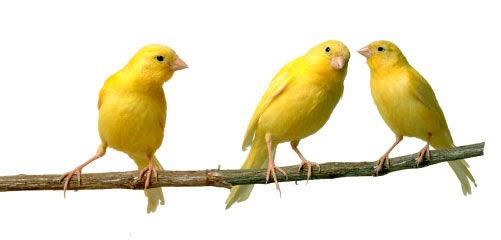
Bird Care Basics

Pet birds can be as attached to you as pet dogs if you treat them right. Read on and find out how!
Diet
A poor diet is the primary reason for illness in birds so take heed.
Dos
- Do check with the pet shop or vet on a suitable diet for your pet bird as different species of birds have different dietary needs. Generally, bird pellets or a safflower based seed mix is suitable for most pet birds.
- Provide plentiful water at least once a day. You should replace the water if it is soiled with droppings. A partially covered water bowl is a good idea if this happens often — the cover helps to prevent the messy bird from defecating in it.
Don'ts
- Do not feed your bird avocado pit and skin, apple seeds, chocolate, raw onions and alcohol. These can be fatal for your pet bird.
Environment
A bird's cage should be at least big enough for your bird to flap its wings without hitting against the bars. Big enough for your pet bird to fly short distances would be even better.
Spend time with your birds and show them affection; especially so if you own parrots. They really like your care and attention!
A clean environment is also important to your pet's well-being. Wash and clean the food and water bowls daily. Remember to clean the cage every week and disinfect it at least once a month. Bleach and hydrogen peroxide are some common disinfectants that you can use. After disinfecting a cage, rinse and dry your pet's home thoroughly before putting the birdie in.
Parakeets and cockatiels like tall cages with horizontal bars they can climb whereas canaries and finches prefer cages that are wider rather than taller.
Pet Bites
Be gentle when holding a pet bird as bird bones tend to be fragile.
Pet Bites
A clean environment is also important to your pet's well-being. Wash and clean the food and water bowls daily. Remember to clean the cage every week and disinfect it at least once a month. Bleach and hydrogen peroxide are some common disinfectants that you can use. After disinfecting a cage, rinse and dry your pet's home thoroughly before putting the birdie in.
Exercise
Exercising your bird will help to increase its lifespan and enables you to spend some quality time with your pet. Exercising can be as simple as bringing it around on a portable perch or giving it a small toy to play with. It's also a good idea to allow your pet bird some fly time. If bird-proofing a room is not feasible, try using a bird harness and leash.
Bathing
Birds have an innate need to bathe. We may not see birds bathing in the wild as a bird's bath can be quite unconventional. For birds that are accustomed to the tropical climate, you can bathe it by using a mist sprayer or simply providing it with a bowl of water. Bathing for birds from dryer climates is more challenging however, as they tend not to like the direct methods their tropical counterparts are used to. For these birdies, try giving them wet leafy vegetables! The vegetable are not just for eating though. It actually simulates the bathing environment of many dry weather birds in the wilds: these birds bathe by rubbing their feathers against wet grass or leaves.
Nails trimming
It's a memorable experience when your pet bird grips you and you yelp in pain while trying to ignore roast bird images flashing in your head. To avoid such painful memories as well as your bird's foot health, it's a good idea to use a pair of bird nail clippers to trim its sharp tips evey now and then. Wrap your bird using a soft fabric, such as a towel, so that you can have a firm yet gentle hold on it. The wrap also serves to blind the bird from the trimming exercise, reducing its anxiety. Talk to your bird while trimming and take care not to trim close to the pink part of the nail called "the quick". In case you accidentally cut too deep, keep close some styptic powder so that you can stop the bleeding fast.
